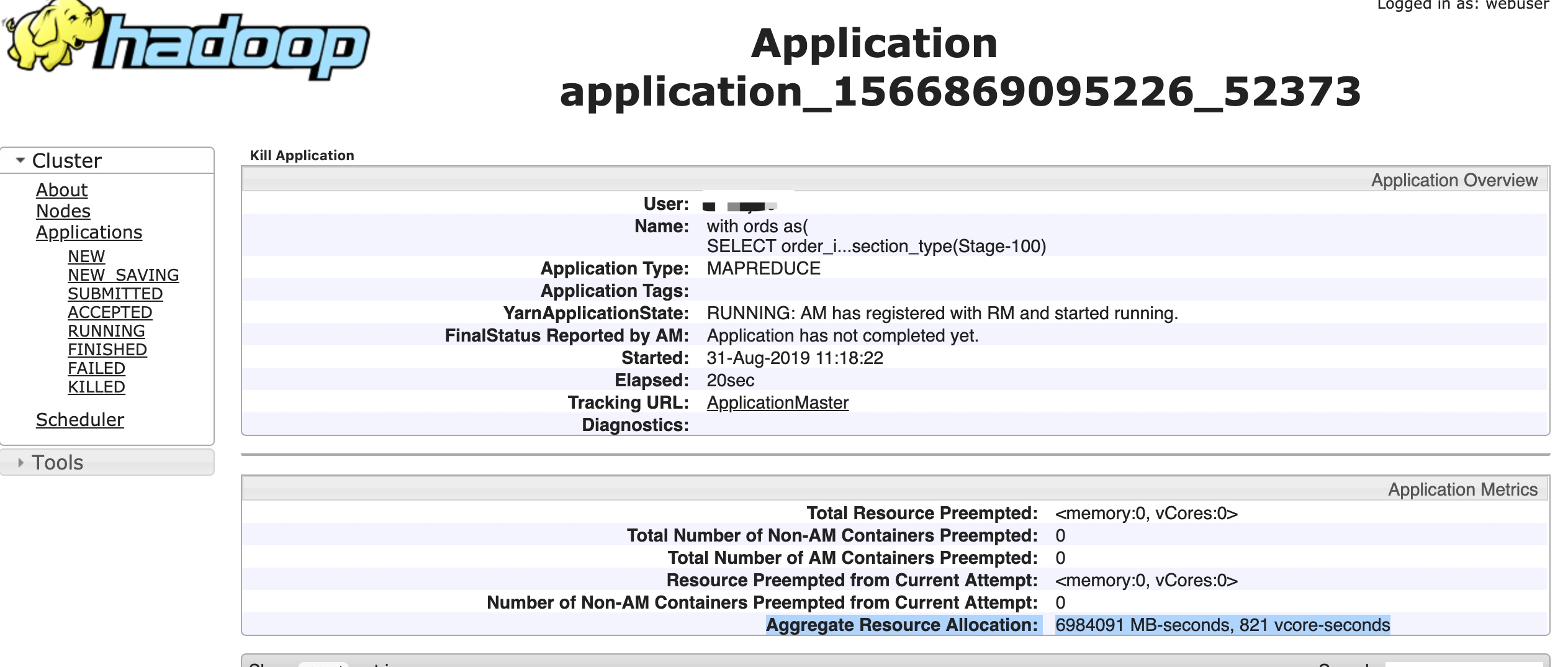YARN任務監控介面Aggregate Resource Allocation指標解析
阿新 • • 發佈:2019-08-31
在YARN的原生任務監控介面中,我們經常能看到Aggregate Resource Allocation這個指標(圖中高亮選中部分),這個指標表示的是任務每秒消耗的記憶體和CPU數量:

Aggregate Resource Allocation是在org.apache.hadoop.yarn.server.resourcemanager.scheduler.SchedulerApplicationAttempt類中進行計算的,主要邏輯如下:
// 資源資訊更新間隔:3秒 private static final long MEM_AGGREGATE_ALLOCATION_CACHE_MSECS = 3000; // 最後更新時間、最後更新時的每秒的記憶體和CPU使用量 protected long lastMemoryAggregateAllocationUpdateTime = 0; private long lastMemorySeconds = 0; private long lastVcoreSeconds = 0; /** * 返回與任務關聯的所有的container每秒消耗的CPU和記憶體資源數量 * @return */ synchronized AggregateAppResourceUsage getRunningAggregateAppResourceUsage() { long currentTimeMillis = System.currentTimeMillis(); // Don't walk the whole container list if the resources were computed // recently. // 判斷是否達到更新條件:當前時間 - 最後更新時間 > 最大更新間隔(3秒) if ((currentTimeMillis - lastMemoryAggregateAllocationUpdateTime) > MEM_AGGREGATE_ALLOCATION_CACHE_MSECS) { long memorySeconds = 0; long vcoreSeconds = 0; // 迭代所有的container,計算每個container每秒所消耗的資源(記憶體、CPU) for (RMContainer rmContainer : this.liveContainers.values()) { // 獲取container的執行時間 long usedMillis = currentTimeMillis - rmContainer.getCreationTime(); // 計算container每秒所消耗的資源(記憶體、CPU) Resource resource = rmContainer.getContainer().getResource(); // 彙總記憶體和CPU使用量 memorySeconds += resource.getMemory() * usedMillis / DateUtils.MILLIS_PER_SECOND; vcoreSeconds += resource.getVirtualCores() * usedMillis / DateUtils.MILLIS_PER_SECOND; } // 記錄最後更新任務資源使用情況的時間、任務最後每秒使用的記憶體和CPU數量 lastMemoryAggregateAllocationUpdateTime = currentTimeMillis; lastMemorySeconds = memorySeconds; lastVcoreSeconds = vcoreSeconds; } return new AggregateAppResourceUsage(lastMemorySeconds, lastVcoreSeconds); } /** * 返回任務使用的資源情況 * @return */ public synchronized ApplicationResourceUsageReport getResourceUsageReport() { AggregateAppResourceUsage resUsage = getRunningAggregateAppResourceUsage(); // 返回任務所使用的資源情況:所使用的container數量、預留的container數量、當前消耗的資源、當前預留的資源、所需的總資源(當前消耗的資源+當前預留的資源)、每秒的記憶體和CPU使用量 return ApplicationResourceUsageReport.newInstance(liveContainers.size(), reservedContainers.size(), Resources.clone(currentConsumption), Resources.clone(currentReservation), Resources.add(currentConsumption, currentReservation), resUsage.getMemorySeconds(), resUsage.getVcoreSeconds()); }
getResourceUsageReport方法是一個用synchronized關鍵字修飾的同步方法,被在org.apache.hadoop.yarn.server.resourcemanager.scheduler.AbstractYarnScheduler類的getAppResourceUsageReport方法中呼叫。因此,synchronized關鍵字在這裡起的是物件鎖的作用,保證在同一時刻多個執行緒更新任務資源使用資訊時,不會產生併發更新問題。
@Override
public ApplicationResourceUsageReport getAppResourceUsageReport(
ApplicationAttemptId appAttemptId) {
SchedulerApplicationAttempt attempt = getApplicationAttempt(appAttemptId);
if (attempt == null) {
if (LOG.isDebugEnabled()) {
LOG.debug("Request for appInfo of unknown attempt " + appAttemptId);
}
return null;
}
return attempt.getResourceUsageRe
